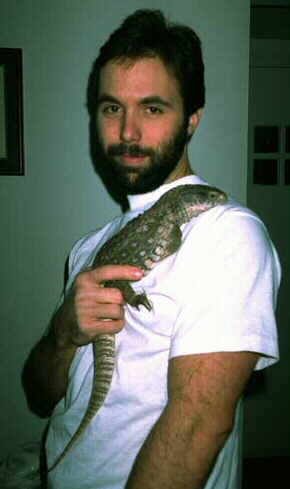
Bernard is my savannah monitor. He is brown with tannish spots across his back. He has a boxy type head, a well rounded body, powerful legs and jaws, a thick tail and a snake like forked tongue. I have raised him from a hatchling size of only 5 inches and in 9 months he is 26 inches long and weighs about 4 lbs. He has a very friendly disposition but his size is intimidating to most people.
Bernard is a great pet. He is content to lay on your lap or shoulder and take in the scenery. As long you handle them daily when they are babies like I have then you will have a very trusting and friendly pet. There are exceptions so when you first pick out the monitor you want don't get a nasty and ill tempered one and always choose a baby, an adult will be nearly impossible to work with.

![]()
Bernard's custom built home is 4ft X 8ft X 5ft. Now I know I could have went a little smaller, but I wanted him to have more than enough room. His cage is wood with plexiglass sliding doors on the front, plexiglass panels on the sides and a screened top over half the cage that provides ample ventilation.

For the floor covering I use crushed walnut shells, but you can use any digestible reptile substrate ( I prefer the walnut shells because it is very easy to scoop "messes" off of them).
Savannah monitors don't climb much so branches or driftwood are not necessary. However, a hiding place, such as a large wooden box is required for privacy and security. Bernard's is about 24 inches long, 15 inches wide, and 8 inches high with openings on both ends.
The lighting in the cage is provided by the two fluorescent bulbs and most importantly the two reptile bulbs. In addition to heat, the reptile bulbs also produce UV rays which are needed for maintaining a healthy monitor. The lights should only be on for about 12 hours a day and turned off at night so the animal stays on a regular cycle. The heat lamp I use doesn't give off much light so I leave it on continually to keep the temperature up. The temperature should never drop below 70 degrees at night and must be in the 85 degree range during the day.
Monitors, like all animals, need water. They enjoy soaking in their
containers as well, so you want to use something big enough for them to
put their whole bodies in. Bernard will even defecate in his tub frequently.
![]()
![]()